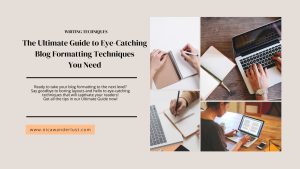Are you tired of pouring your heart and soul into creating amazing blog content only to have it go unnoticed? Do you struggle with capturing your readers’ attention and keeping them engaged throughout your posts? Fear not, because the ultimate guide to eye-catching blog formatting techniques is here to revolutionize how you present your content. In a world where attention spans are dwindling and competition for online visibility is fierce, mastering the art of captivating blog formatting is essential for any aspiring blogger or seasoned professional. From stunning visuals and compelling headlines to strategic use of white space and typography, this comprehensive guide will equip you with the tools and techniques needed to transform your blog into a visual masterpiece that demands attention.
In the vast sea of online content, attention is constantly challenged to be captured. While compelling content crafting is deemed crucial, its presentation plays an equally significant role. Enter blog formatting – the art of organizing and styling content to make it visually appealing and easy to digest. This ultimate guide will explore key eye-catching blog formatting techniques that can elevate content and keep readers coming back for more.
1. Headings and Subheadings: The First Impression Matters
Headlines and subheadings of a blog are the first things readers notice. Compelling and informative language is to be used. Clear language hinting at the value content provides should be employed. Long paragraphs should be broken up with subheadings to create a visually appealing structure, making it easier for readers to scan content and find what they’re looking for.
2. Engaging Introduction: Reader’s Attention Captured from the Start
The tone for the entire blog post is set by the introduction. A hook that grabs the reader’s attention and encourages them to keep reading should be created. Whether it’s a thought-provoking question, a surprising fact, or a compelling anecdote, it should relate to the content and entice the audience to stay.
3. Use of White Space: Less is More
A cluttered blog overwhelms readers and can drive them away. White space should be embraced to give content room to breathe. Text should be broken up into short paragraphs, bullet points, and images. This enhances readability and creates a more inviting and visually appealing layout.
4. Images and Multimedia: A Thousand Words Told by a Picture
Eye-catching visuals should be integrated into blog posts. High-quality images, infographics, and videos can enhance content and provide a more immersive experience for readers. Ensure that multimedia elements are relevant to the text and serve to reinforce the message.
5. Consistent Branding: A Visual Identity Established
A consistent visual identity for the blog should be developed. This includes using a cohesive color palette, fonts, and styles that align with the brand. Consistent branding creates a professional and recognizable look, helping readers associate content with a unique identity.
6. Bullet Points and Numbered Lists: Readability Enhanced
Complex information should be broken down into easy-to-digest formats. Bullet points and numbered lists not only make content more readable but also emphasize key points. This formatting technique is particularly effective for step-by-step guides, tips, and lists.
7. Call-to-Action (CTA): Reader Guidance
Reader engagement should be encouraged by incorporating clear and compelling calls to action. Whether asking for comments, sharing on social media, or directing them to related posts, readers should be guided on the next steps after consuming content.
8. Mobile Responsiveness: Optimization for All Devices
With the increasing use of smartphones and tablets, ensuring that the blog is mobile-friendly is non-negotiable. A responsive design that adapts to different screen sizes should be chosen, providing a seamless reading experience for the audience, regardless of the device used.
9. Font and Typography: Key to Readability
The right font should be selected, and a consistent typography style should be maintained for readability. Clear and legible fonts should be opted for, and attention should be paid to font size and spacing. A balance that is easy on the eyes and complements the overall design should be strived for.
Conclusion
In the world of blogging, content is deemed king, but the crown is worn by presentation. By implementing these eye-catching formatting techniques, a visually stunning and reader-friendly blog that not only captivates the audience but also establishes a strong and memorable online presence can be created. These techniques can be experimented with, the best fit for the brand can be found, and the blog can become a go-to destination for information and inspiration.

